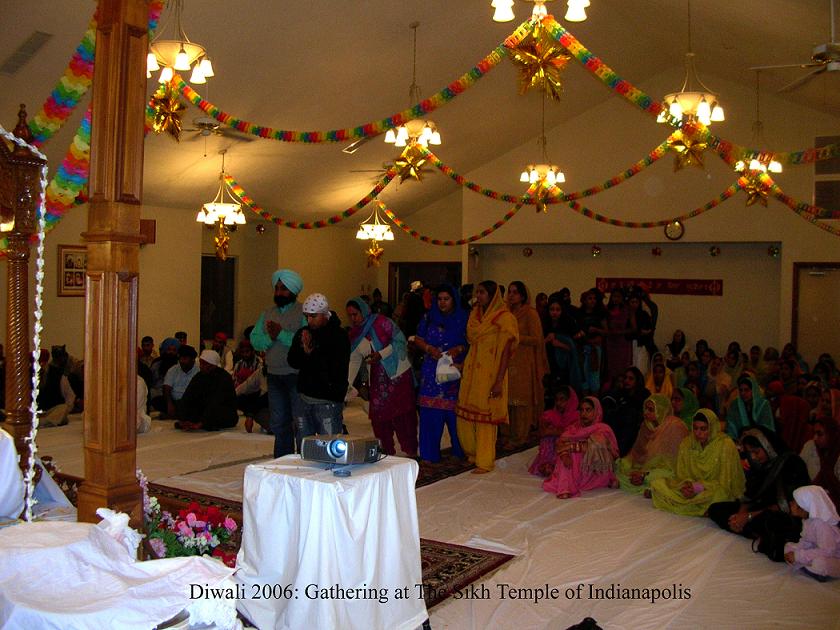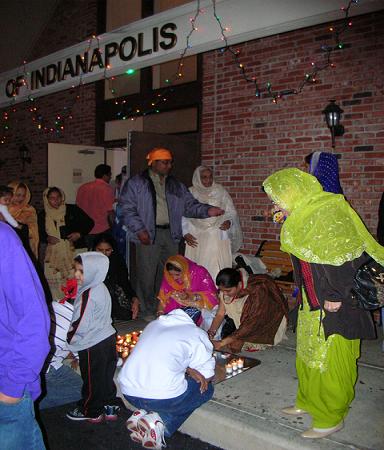By Kanwal Prakash “KP”
Singh
DIWALI
CELEBRATIONS IN THE U.S.
Much like in India and around the world wherever Indian Diaspora
have set down roots and made their new home, Diwali, the great
Indian Festival of Lights, celebrations have taken on more
international and regional flavor in recent years. There is
the usual distinct sense of nostalgia and the unusual realization
of the increasing recognition of Diwali as a major cultural
and religious holiday, much like Hanukkah (the Jewish Festival
of Light), Kwanza (inspired by African traditions), Eid (the
Muslim sacred holiday) and Christmas, the major global religious
holiday.
Diwali has found friends in high places: Diwali celebration
at The White House, in City Halls, State Capitols, and civic
and diplomatic functions. Efforts are underway to have a special
stamp issued by the U.S. Post Office to recognize Diwali as
a major component of the changing and emerging cultural and
spiritual landscape of the U.S.
Over the past 42 years that I have been in the U.S., the
annual Diwali gatherings have gone through a gradual and significant
transition. From very modest bring-a-dish casual affair, to
gatherings in private homes or classrooms at local colleges
of early days, Diwali celebrations have grown to elaborate
colorful show-and-tells in major hotel ballrooms with delicious
sit-down dinners followed by entertainment by local talents
and special guests. Big cities, like New York and on the West
coast, have been organizing huge and colorful Diwali Melas,
outdoor bazaars, and festive enactments to bring home a little
of the Indian cultural experiences and spirit to serve their
large Indian American populations and others interested to
learn about this great and ancient holiday tradition. Today
the festival of Diwali is firmly transplanted in community
cultural calendars, attracts a fair amount of media attention,
and many non-Asian Americans to its annual celebrations.
As the Indian community has grown in Indiana and throughout
the country, many unique regional elements, expressions, and
traditional inspirations, and personal experiences and memories
of events back home in India, and needed adaptations reflective
of the time and place have made Diwali a multi-faceted, multi-textured,
and multi-cultural affair.

This year in Indianapolis on Saturday, October 21, the actual
Diwali day, there was a cultural function and Puja (religious
service), food and fireworks at the Hindu Temple of Central
Indiana. At the Sikh Satsang (congregation) of Indianapolis,
a special worship service, deepmala (lighting of traditional
earthen lamps), and fireworks, sweets and Langar (community
meal) commemorating the safe triumphant return in 1620 to
Amritsar on Diwali day of Guru Hargobind Sahib, the sixth
Sikh Guru, after a long imprisonment in the Gawaliar Fort
by Emperor Jahangir, was celebrated. This year’s Diwali
was celebrated with tremendous excitement at The Sikh Temple
by over 350 people
 
There were many family style gatherings of friends and families
where the day was marked by sharing of meals, exchange of
gifts, and other special talents and activities that guests
brought to the feast. The growing community offers many dimensions
and several regional celebrations (Gujarati, Punjabi, South
Indian), from strictly religious to fun festivities and reliving
and recreating traditional and favorite family or community
rituals and introducing them to new generations growing up
in America. It is a matter of increasing pride and privilege
as we preserve our culture and remember their rightful place
in our life and spirit and integrating them into international
cultural celebrations.
Then there are people like me, who having been deeply involved
in early formation and personal witness to the transformation
of Indian community in central Indiana, who have not attended
Diwali functions since 1984, the year that brought much pain
to the Indian community and the Sikhs around the world. For
me and my family, Diwali was another day to reflect on: my
journey that began in Jaranwala (District Lyallpur) before
the Partition of India; my beloved family in India and up-bringing
under the guidance of a very enlightened father. I paused
to thank Waheguru (Wonderful Lord) for my unimagined blessings
as an American and for the many fond and beautiful memories
of Diwali, other festivals as we were growing up in India
and settling in Indiana that enrich my soul and remind me
of my cultural connections and proud heritage.
Instead of four or five families from the Indian subcontinent
in 1967, now there are nearly 5,000 families in central Indiana,
two Sikh Gurdwaras, a Hindu Temple, an India Community Center,
and over a dozen Indian restaurants. There are grocery, ready-made
garment, music and jewelry stores, and any thing that one
may need for making Diwali and other festivals fun, culturally
complete, and special. With over two million immigrants from
the Indian subcontinent now in the U.S., we have no doubt
that Durga Puja, Diwali, Holi, and Baisakhi will find their
own place among the major American ethnic holidays, a place
in our schools, civic life, and calendar, and especially as
a major commercial enterprise in the years to come. Just imagine
that!
A very Happy Diwali (Hindu, Sikh, Buddhist holy day), Eid
Mubarak (Muslim holy day), a Blessed and Glorious Bandi Chhor
Divas (Sikh holy day) and to all people everywhere under God's
mighty heavens. May each faith, family, and community find
much to celebrate and hope for as we go forward from these
happy celebrations into the coming and shared holiday season
of many faiths and cultures.
May these ethnic, cultural, and religious celebrations continue
to bring humanity closer in spirit to learn about the many
common cultural and historic threads and themes that connect
us one to the other; inspire each of us to honor and integrate
the true lessons of these commemorations into our times, our
lives, and our journey.
Kanwal Prakash “KP” Singh
Indianapolis, Indiana USA
www.KPSinghDesigns.com

|
|